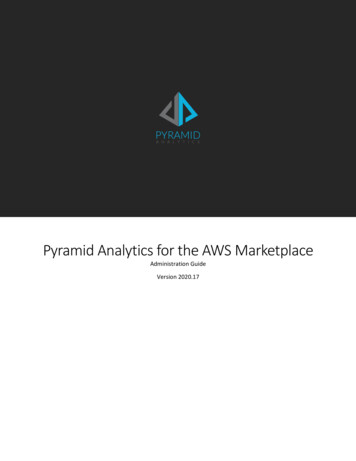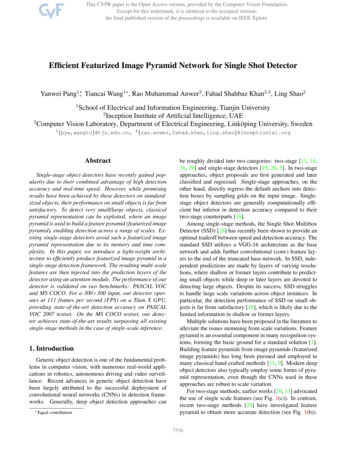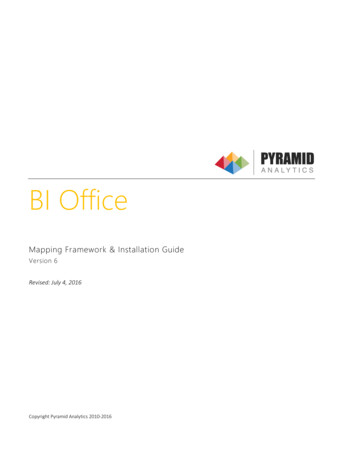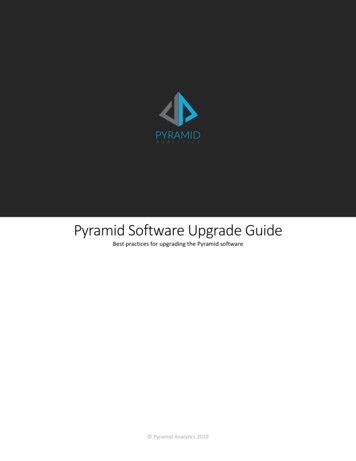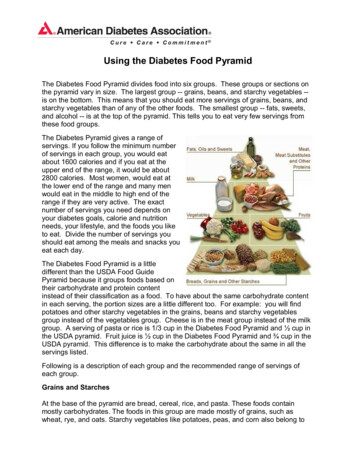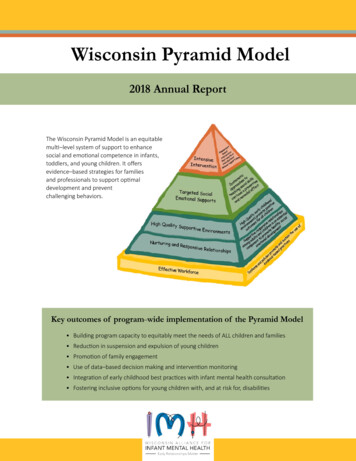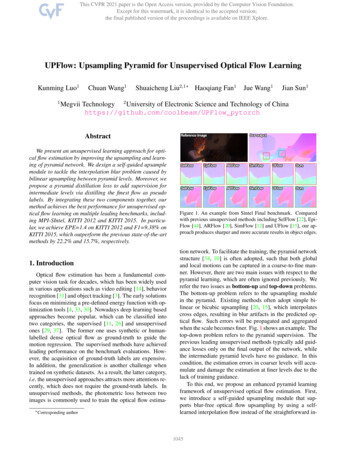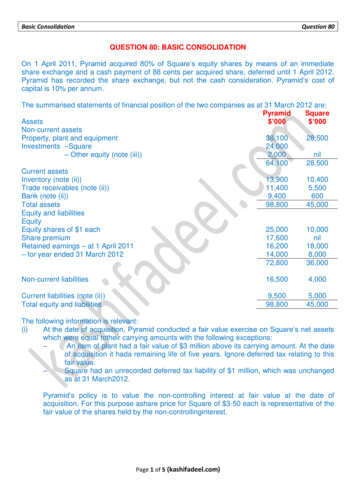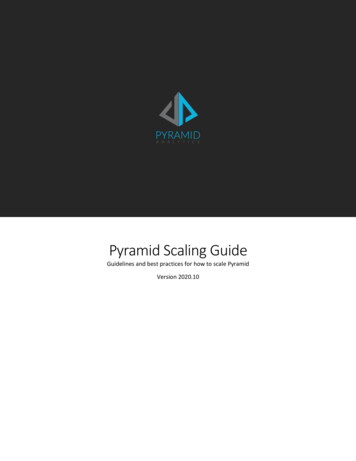
Transcription
Pyramid Scaling GuideGuidelines and best practices for how to scale PyramidVersion 2020.10
ContentsOverview . 3Data Modeling . 12Steps for Scaling Pyramid . 3Publications . 12Pyramid Server Tiers . 3Provisioning and System Maintenance . 12Core Servers . 3Scaling Strategies . 13Peripheral Servers . 4Techniques . 13Optional Services . 4Prototype Scaling . 13Pulse . 4Incremental Build Out. 13Basic Scale Models . 5Guidance . 13Simple Standalone . 5Single and Dual Machine Deployments . 14Split Out / Scale Up . 6Small Deployments . 14Scale Out . 6Medium Deployments . 14Tier Communication. 6Large Deployments . 14Multi-node options . 6Enterprise Deployments . 15Multi-node Installation Procedures . 7Key Server Designations . 15MVP: Minimum Viable Product . 7Real-Time vs Batch. 15Removing Nodes . 7AI – Augmented Analytics and Machine Learning 15Scaling Considerations . 8In-Memory . 15Hardware . 8Scaling Pulse . 16General Resources . 8Performance Bottlenecks . 16Virtualization . 8Slow real-time querying. 16Networking. 8Overwhelmed Data Stack . 16Host Operating System . 8Slow Content Management . 16Client Browser . 9Other Factors . 16Data Stack . 9Appendix . 17Data Footprint . 9Load Testing Design . 17Depth vs Breadth . 9Database Repository Considerations. 18Activity Volumes . 10Deployment suggestions . 18User Concurrency . 10Tactical Suggestions . 18Query Size and Complexity . 11In-Memory Size Guidance. 19Content Design . 11Pyramid’s Baseline Load Testing Results . 20Non-Query based Activities . 122 Pyramid Scaling Guide
OverviewScaling an analytics platform can be complicated due to the many variables and factors that affect the performance ofthe “analytics stack”. These factors include hardware choices; networking; the host operating system; the clientbrowser; the underlying data stack technologies; and the data footprint itself. Other key variables relate to activityvolumes - which is a combination of concurrent user patterns; typical query sizes / complexity; and content design.Due to this complexity, there is no set formula that can be easily applied to every deployment scenario, beyond thetechnical steps needed to create a scaled-out instance. Instead, there are a variety of best practices and ideas on how tocreate scale and ways to measure what factors in the stack need attention.The good news is that Pyramid was designed to scale up and out to meet those needs. However, you will need toconsider other aspects of your deployment in arriving at the right solution. This guide is designed to help you come tothe right decisions.The first step is understanding how Pyramid 2018 itself can be installed.Steps for Scaling PyramidThe following explains different options for how Pyramid can be deployed. An explanation of the server tiers in Pyramidis first required to better understand these options.Pyramid Server TiersPyramid is made up of a set of server-side Java service application tiers that work together to respond to user requestsand analytic tasks. The tiers are broken in 5 core servers; 2 peripheral servers, 3 optional servers and the Pulse server.Core Servers Web Server: This tier hosts the client application and provides Resource usage is medium low.the main entry and exit point for requests and responses toCPUboth the client tools and API calls.MemoryDiskNetwork Router Server: This tier provides the message routingdecisions required in a multi-node deployment.Resource usage is low.CPUMemoryDiskNetwork Runtime Server: This tier processes all real-time requests andtasks like querying, content management and administrativefunctionality.Resource usage is high, and speed is key.CPUMemoryDiskNetwork Task Server: This tier processes all batch and off-line requestsand tasks such as data preparation/ETL jobs, publications, logcleaning and provisioning.Resource usage is high, but speed it less key.CPUMemoryDiskNetwork3 Pyramid Scaling Guide
Augment Analytics Server: This tier (also known as the “AI”server) processes all AI and machine learning requests relatedto Python, R and NLQ.Resource usage is high, but speed it less key.CPUMemoryDiskNetworkPeripheral ServersPeripheral servers cannot be installed separately and are installedautomatically as companion services with the core tiers. File Server: This service is installed on each machine hostingPyramid and facilitates all file and data movements betweenservers in a multi-node deployment.Resource usage is low.CPUMemoryDiskNetwork Agent: This service is installed on each machine hostingPyramid and monitors the health of all Pyramid servicesinstalled.Resource usage is very low.CPUMemoryDiskNetworkOptional Services Windows Connector Service: this optional tier is neededwhen customers plan to query Microsoft OLAP or Tabulardata sources. This tier is not required if these data sources arenot used.Resource usage is high, and speed is key.CPUMemoryDiskNetwork In-memory Server: this optional service is designed to houseand run Pyramid ’s in-memory database server. This tier is notrequired if the in-memory engine is not used1.Resource usage is high, and speed is key.CPUMemoryDiskNetwork Repository Database Server: This optional server is used tohouse the database repository holding all the meta structuresused in the platform. The functionality itself is NOT optional.However, customers can choose to use the internalPostgreSQL database engine or use a ‘remote’ databaseserver to house the repository (PostgreSQL, MS SQL, Oracle).Resource usage can be medium to high.Pyramid Pulse Server: this tier is NOT part of the standardinstall – and is by designed installed on separate remotehardware to connect remote databases to the main Pyramidinstallation. Scaling the Pulse server is covered separatelybelow.Resource usage is high, and speed is key.CPUMemoryDiskNetworkPulse 1CPUMemoryDiskNetworkThe geospatial mapping tools in the application use a special database housed in the in-memory engine. If it’s not installed, themapping engine will not be available.4 Pyramid Scaling Guide
Basic Scale ModelsSince each tier of Pyramid can be installed on one or more machines in almost any combination, the scale outpermutations are almost endless. The following 3 basic models shown in figure 1 below cover the skeletal approaches.Note that the use of firewalls and separate data stack machines is shown in a highly simplistic flow below. They may notbe appropriate in any all situations and the network configurations may be far more complex.ScalingSplit out / Scale UpScale outPyramid 2018 ServersInternet /ExtranetClientSimple StandalonewebwebrouterruntimetaskruntimeData stacktaskrouterFigure 1 Basic Scale ModelsSimple StandaloneThe simplest is to install all Pyramid tiers on a single machine. If the host server is big enough2 this approach is the leastcomplicated and fastest deployment model. This approach includes all the core, peripheral and optional servers installedon one machine.2“Big” implies something strong enough to house the entire Pyramid application and provide enough processing resources forquerying, batch processing and the running of all other peripheral services and the host operating system. As described in thisdocument each deployment is unique. So, there is no one definition of what that is.5 Pyramid Scaling Guide
If resourced well, Pyramid will comfortably use all the server’s resources and scale up as needed. Critically, the datastacks that are being used for analyses should be on separate hardware unless they are small, or the hardware housingPyramid can accommodate its load as well.Split Out / Scale UpThis type of model involves splitting out and installing each of Pyramid 5 core tiers and 3 optional tiers on separatemachines – creating a multi-node cluster. This includes variations where 2 or more tiers share hardware in varyingcombinations. This approach allows customers to put resource-intensive tiers on their own hardware – and thereforeprovides a more efficient use of given resources. It also offers better scale up options for any given tier/server withoutwasting those same resources on the low-demand tiers (e.g. if the solution needs more processing for real-timequerying, the Runtime server can be allocated more CPU’s or memory in a virtualized environment). The 4 tiers mostrelevant here being the Runtime, Task, Windows Connector and In-memory servers. Putting the web and router serverson the same machine is a typical approach, with other tiers on their own hardware. In addition, using a remote databaseserver to house the repository is another option.The data stacks that are being used for analyses are usually on separate hardware - in much the same way that eachPyramid tier is separated out.Scale OutThe scale out model is a variation of the split out, except that it involves adding one or more duplicate tiers on multiplenodes into the cluster. This approach involves adding multiple servers to unblock bottlenecks on any given tier. So, forexample, if heavy batch processing is required, customers can deploy 2 or more task servers while only using 1 web,runtime and router server.While the scale out model does not preclude scaling up hardware for any tier, it does facilitate failover and highavailability and the use of different physical servers for scaling. There is also evidence that scaling out produces slightlybetter results than the same resources used for scaling up.Again, a remote database server is typically used to house the repository and the data stacks that are being used foranalyses are on separate hardware.Tier CommunicationIn the split out and scale out models, the Router server handles all communication flows and ensures that all datapackets move around the different tiers efficiently and effectively.Multi-node optionsEvery tier in the Pyramid stack can be installed multiple times in the cluster. The following considerations should benoted in a multi-node environment: For core tiers:o The Router server acts in an active-passive, failover model. This means, one router is the master, andthe secondary routers are passive until the primary fails.o The web servers can act in an active-active, load balance model. However, the customer needs to usetheir own load balancing technologies as part of their web farm strategy.o The runtime, task and AI servers act in an active-active, load balance model. This means jobs are sharedbetween all tiers all the time. The Router server handles the load balancing.For Optional Tierso The Windows connector acts in an active-active, load balanced model. The Router server handles theload balancing.6 Pyramid Scaling Guide
ooThe in-memory engine is only available as a single node installation. This means you can have multiplein-memory servers hosting multiple databases and models. However, they cannot be load balanced.The database repository clustering options are based on the underlying technologies. PostgreSQL,Microsoft SQL and Oracle all offer multi-node clustering options. However, the setup and maintenanceof these high-availability systems is the responsibility of the customer.Multi-node Installation ProceduresBasic instructions for installation can be found in Pyramid online help.To create a multi-node installation of Pyramid, use one of the advanced installers (Windows or Linux) and choose the“multi-server” option. From the tier list, select which components you wish to install.The initial installation, regardless of tier type, must include the creation and initialization of the database repository(choose “new”). All subsequent node installations must then point to that repository (choose “current”). By using thecommon repository, we are simply adding the new node to the existing installation cluster. Once added, the cluster willself-recognize the components and nodes and use them accordingly.MVP: Minimum Viable ProductWhen the minimum requisite tiers are available in the cluster, “MVP” status is achieved, and the product can beinitialized and become partially functional. MVP is achieved when at least 1 web, 1 runtime and 1 router tier is addedto the cluster (on one or more nodes). It is highly recommended to add a task server as well, and to add the router lastin the installation sequence.Once the application is initialized users can start working with the product. Post MVP, new nodes can easily be added tothe cluster by installing them as needed and using the common repository instance.Removing NodesUninstalling the software from a server will remove the node from the cluster. However, care should be taken that theMVP tiers remain intact. If they are missing, the cluster will fail.7 Pyramid Scaling Guide
Scaling ConsiderationsBefore you can pick a scaling strategy, you need to consider all the variables that can affect the approach. As mentioned,this includes hardware choices and networking; the host operating system; the client browser; the underlying data stacktechnologies; and the data footprint itself. The other key variables relate to activity volumes which is a combination ofconcurrent user patterns; typical query sizes / complexity; and content design requirements.HardwareGeneral ResourcesData analytics is a resource intensive domain, and requires numerous calculations and CPU cycles; plus, it also needs diskspace to handle the vast volumes of data. Often, resources allocated to the environment are extremely understated. Memory is used heavily by Pyramid to improve performance and processing. This impacts the runtime, task,windows connector and in-memory tiers. Providing adequate memory allows bigger jobs to run without diskpaging. Memory is less relevant for the router and web tiers.CPU is used heavily by Pyramid for processing. Like memory, this impacts the runtime, task, windows connectorand in-memory tiers. Providing adequate CPUs allows more jobs to run concurrently without queueing. CPUs areless relevant for the router and web tiers. A key aspect to note is that a given task must run on a single CPUthread (or core) at any time. So, for example, only 16 activities can run on 16 cores at a given time. If there aremore jobs, the CPUs merely “thrash” and “switch” activities and it seldom produces good performance.Disk is not crucial for most activities in Pyramid. However, it is used as the storage medium for the databaserepository and can heavily affect its performance. Disk is also used for data preparation/ETL jobs whenprocessing large files. The read/write performance can be affected by slow disks for these types of operation.VirtualizationGenerally, virtual machines and bare metal machines will operate with performance profiles expected from thosetechnologies in typical conditions. However, over allocation of CPUs and memory in virtualized deployments willseverely impact performance (as described above).NetworkingAs Pyramid is usually connecting to networked resources (both intranet and extranet), networking can have an impacton performance. Server-side tiers should be installed on the same network segment (in the same domain), with fast NICsand switches. The data stacks that will be analyzed by Pyramid should follow suit. Where possible, Pyramid should beinstalled on the same network segment as the data stack to improve performance.Client connectivity is also affected by networking speed. As part of the Pyramid design much emphasis was placed onreducing the networking requirements in Pyramid ’s client-server communication design. Nevertheless, network latencyis something that will affect the perceived speed of the application.Host Operating SystemBoth the Windows and Linux builds of Pyramid can scale up resource usage as needed. In some operations, the Linuxversion is shown to be slightly faster at processing the Java code base. However, the In-memory engine performs slightlybetter on Windows.Care should be taken that in both host systems, all non-essential competing processes are minimized to allow Pyramidto fully utilize all resources. Good examples include performance logging, anti-virus applications and other competingapplications.8 Pyramid Scaling Guide
Client BrowserThe choice of client browser has a relatively large impact on performance owing to the difference in browsertechnologies and engines when processing the HTML5 content. Generally, Chrome and Firefox provide the fastestexperience for users, followed by Opera. Other client browser technologies such as Internet Explorer, Edge and Safarisupport HTML5, however performance is slower.In the event a customer cannot deploy a fully compatible HTML5 browser, the Pyramid Desktop client provides aconvenient alternative and involves a small installation process.Data StackThe database engine that will be analyzed by Pyramid has a significant impact on the performance and scalability of theplatform. While it may be convenient to connect directly to various stacks, they may not be properly designed for thespeed of data analytics or properly configured for such operations. As such, care should be taken on how data stacks areprepared for analysis and expectations matched accordingly. Explaining how to approach this item is beyond the scopeof this document, however, some general ideas are provided below: Relational databases are generally weak for high-speed, high-concurrency analytic queries. If used, they need tobe properly optimized with file partitioning, column indexing and table structure. Relational engines are alsovery sensitive to hardware choices – especially disk speed.In-memory databases perform extremely well for high-speed analytic queries. However, they are very sensitiveto CPU resources and are limited by available memory. If memory is sufficient, concurrency is heavily affectedby the number of available core CPUs to process requests.OLAP databases have a similar profile to in-memory systems, however, they often store results on disk as well.This means they are less reliant on memory but are more affected by disk speed and CPUs.MPP databases are high-end solutions designed for high-speed, high-concurrency queries. However, the properoptimization steps for each technology should still be followed.Data FootprintObviously, the larger the data footprint, the bigger the impact on performance. This is further impacted by the type ofdata stack technology (described above). Pyramid makes querying databases easy for end-users, which allows them toconsume enormous amounts of detailed data through the engine. When the data footprint is extremely large, thepossibilities for performance issues can increase. Often, the best approach is to put an end-user education program inplace to ensure analytical best practices are adopted and the systems are not misused.The design of the data footprint has a big impact on performance. Often, this is unavoidable because it reflects businessrequirements. The variations and techniques for solving performance problems across all data source types are beyondthe scope of this document. However, the following tips are applicable to many relational database engines.Depth vs BreadthUsually, the breadth of a database (number of tables, joins and number/type of columns) can have a bigger impact onperformance than the depth (number of rows).For relational technologies, ‘depth’ issues are usually solved with file structures, table partitioning and disk speed.‘Breadth’ issues, on the other hand, require more attention and usually involve structural changes to the database.Here are some general tips for handling breadth issues on structured relational data sources:9 Pyramid Scaling Guide
Reduce the number of table joins needed to query the system. Effectively, this means trying to keeptransactions to a single fact table, with a simple, single inner join to all peripheral dimensional tables.Where possible ensure dimensional tables are denormalized down to single tables rather than chains of tables.Star schemas are best, with snowflake schemas being even better.Instead of using columns from the fact table for dimensional attributes, create dimensional tables or indexedviews BEFORE adding them to the model schema. The cost of finding unique values and keys from deep facttables for each query can be a very expensive and will heavily affect performance.Index all primary and foreign key columns. Also, relational databases often perform better with numeric keys.Inner joins are generally the cheapest joins to create and process. So, try and ensure keys are a perfect matchbetween tables.Reduce or remove all “blob” columns from tables that will be used for analytics. Due to their size, they canimpede read speed. Instead, put them in adjunct tables that can be drawn in if needed.Activity VolumesThe amount and size of activities planned for the system have a profound impact on the scaling strategy. Activities areclassified as all events triggered in the system in each period. This means user concurrency as well as the types ofqueries the users will run are the key aspects to measuring the size and volume of activity.User ConcurrencyThe number of expected concurrent users on the system has a tremendous impact on performance. Each user’sinteractions with the system produces events and transactions that mostly need to be processed on the servers, sincethe client application is delivered through a thin, JavaScript web application in the user’s browser.Like all client-server designs, Pyramid was architected to comfortably handle concurrent requests from multiple users atthe same time in a fast, efficient manner. But there are limits to everything. The scaling options are designed to givecustomers the best opportunity to increase those limits as needed.Measuring ConcurrencyThe hardest issue to resolve with concurrency relates to determining the expected usage of the product expected overtime. Usually, this is evaluated for a given period: daily, weekly or monthly. The simplest approach is to simply decidethat every user in the system could theoretically access it at the same time. However, this is usually a grossoverestimation of the figures, and can lead to expensive hardware resourcing.Many enterprise applications are rated on a 10% concurrency rate for a given user population. Pyramid has no simpleanswer to this question and cannot therefore make a specific recommendation on scale out formulations. Instead, ourapproach is to start with a reasonable and modest set of concurrency assumptions; measure usage over time; andcontinue resourcing the cluster as needed from there.There are numerous tools for measuring actual concurrency. However, the transaction and audit logs in Pyramid itselfprovide the most accurate way of measuring both the number of concurrent users as well as the number of concurrentquerying events in the system.Peak vs AverageOnce usage is better understood, the next key step is to decide if the system’s performance should be scaled out forpeak periods or to tolerate some slowness and instead cater for average usage periods (with lower resourcing). Theplatform’s design is centered around the idea that it is easy to keep adding or modifying software and hardwareresources in the system, so one approach does not preclude the other.10 Pyramid Scaling Guide
Query Size and ComplexityWhile the number of concurrent users is a key factor in determining the scale strategies, an equally importantconsideration is the types of queries users will run. While user usage patterns can be become more and morepredictable over time, query patterns can remain elusive. As such, a strong transaction monitoring regime usingPyramid’s logs is key to refining query patterns.Query SizeRegardless of the pattern, queries affect performance as follows: Normal queries (up to 500 rows by 4-8 columns) are highly scalable, because the data stack, Pyramid servers andPyramid client can process and display results quickly and efficiently. Most analysts would admit that queriesexceeding this size are generally not analytical. Rather they are data fishing exercises or data extractionprocesses.Bigger queries (up to 5000 rows by 4-8 columns) are still scalable, although they are generally uselessanalytically unless they are viewed in ‘data reduction’ visualizations (scatter, tree map etc.).Large queries (10,000 rows by 8 columns) require more processing time by both the data stack and Pyramid –and will consume more network bandwidth. Client browsers will also be impacted in some situations whenrendering results. These queries are either built by mistake or are used for data extraction.Mega queries (100,000 rows by 8 columns) should be used rarely and will impact all tiers in the stack.Therefore, if queries are normal to big, scale out strategies will be less concerned with query size. If querying is on thelarger side, than the scaling strategy must take this into account (especially the data stack).Query ComplexityThe complexity of a query is driven by the several elements and can vary greatly between data technologies. Thefollowing broadly applies to all data stacks: Number of joins needed in the SQL statement. The more joins, the slower the query response, and the greaterthe data stack will need to work to respond. Joining has a greater impact on some of the newer data engines likeRedShift, BigQuery, Presto and Drill. Keeping the data model schema simpler cab reduce this issue.Calculations impact performance. The heavy use of custom calculations (members or measures) will affectperformance in both MDX and SQL.MDX queries are affected by detail or grain, and the level of aggregation that may be available in the cube.Tabular results are not generally affected by grain. However, they are much more sensitive to calculations anddimension nesting. If granular querying is required, consider using an alternative engine to SSAS OLAP cubes.Content DesignPerformance is basically a function of the number of users (a) multiplied by the number of queries (b) multiplied byquery size and complexity of a queries (c).Content design (b), dictates the number of queries to be executed in each analysis. While most of the content designdecision is driven by business requirements that are generally inflexible, it is worth understanding their impact.Dashboards and PublicationsWhen users build dashboards, they typically include 2 or more queries on the visible canvas, and these are usuallyaccompanied by filters (or slicers). When launched, the engine needs to draw all these elements concurrently and ittherefore affects performance. Reducing the number of visible elements on a canvas lightens the load.11 Pyramid Scaling Guide
Filter and SlicersMost users do not realize that filters (slicers) are also generated by queries to the same data source and requireprocessing and rendering. Further, slicer lists can become exceedingly large (in the thousands of elements). Reducingslicers or limiting their element size will also lighten the load.CascadingWhen slicers are cascaded (x affects y, y affects z; etc.), they need to be executed in order and then injected into thefinal query. This prevents asynchronous processin
3 Pyramid Scaling Guide Overview Scaling an analytics platform can be complicated due to the many variables and factors that affect the performance of the analytics stack _. These factors include hardware choices; networking; the host operating system; the client browser; the underlying data stack technologies; and the data footprint itself.
